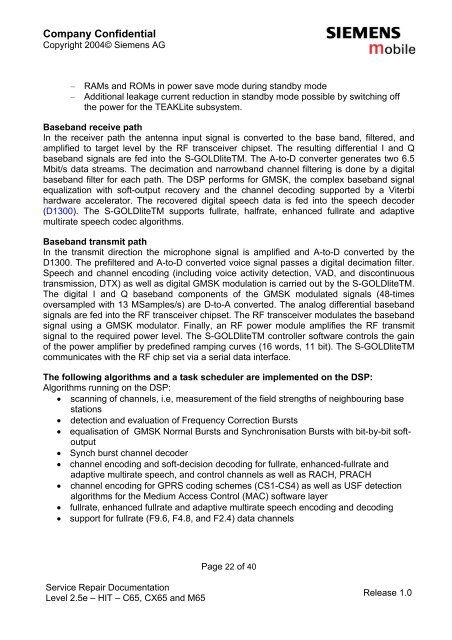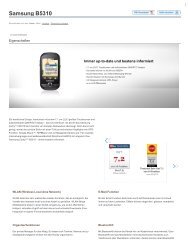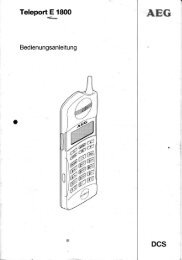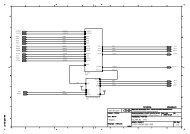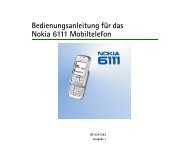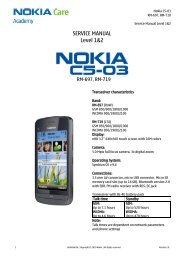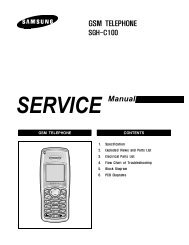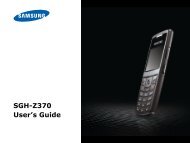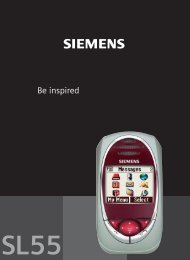Service Repair Documentation Level 2.5e – HIT ... - Altehandys.de
Service Repair Documentation Level 2.5e – HIT ... - Altehandys.de
Service Repair Documentation Level 2.5e – HIT ... - Altehandys.de
You also want an ePaper? Increase the reach of your titles
YUMPU automatically turns print PDFs into web optimized ePapers that Google loves.
Company Confi<strong>de</strong>ntial<br />
Copyright 2004© Siemens AG<br />
<strong>–</strong> RAMs and ROMs in power save mo<strong>de</strong> during standby mo<strong>de</strong><br />
<strong>–</strong> Additional leakage current reduction in standby mo<strong>de</strong> possible by switching off<br />
the power for the TEAKLite subsystem.<br />
Baseband receive path<br />
In the receiver path the antenna input signal is converted to the base band, filtered, and<br />
amplified to target level by the RF transceiver chipset. The resulting differential I and Q<br />
baseband signals are fed into the S-GOLDliteTM. The A-to-D converter generates two 6.5<br />
Mbit/s data streams. The <strong>de</strong>cimation and narrowband channel filtering is done by a digital<br />
baseband filter for each path. The DSP performs for GMSK, the complex baseband signal<br />
equalization with soft-output recovery and the channel <strong>de</strong>coding supported by a Viterbi<br />
hardware accelerator. The recovered digital speech data is fed into the speech <strong>de</strong>co<strong>de</strong>r<br />
(D1300). The S-GOLDliteTM supports fullrate, halfrate, enhanced fullrate and adaptive<br />
multirate speech co<strong>de</strong>c algorithms.<br />
Baseband transmit path<br />
In the transmit direction the microphone signal is amplified and A-to-D converted by the<br />
D1300. The prefiltered and A-to-D converted voice signal passes a digital <strong>de</strong>cimation filter.<br />
Speech and channel encoding (including voice activity <strong>de</strong>tection, VAD, and discontinuous<br />
transmission, DTX) as well as digital GMSK modulation is carried out by the S-GOLDliteTM.<br />
The digital I and Q baseband components of the GMSK modulated signals (48-times<br />
oversampled with 13 MSamples/s) are D-to-A converted. The analog differential baseband<br />
signals are fed into the RF transceiver chipset. The RF transceiver modulates the baseband<br />
signal using a GMSK modulator. Finally, an RF power module amplifies the RF transmit<br />
signal to the required power level. The S-GOLDliteTM controller software controls the gain<br />
of the power amplifier by pre<strong>de</strong>fined ramping curves (16 words, 11 bit). The S-GOLDliteTM<br />
communicates with the RF chip set via a serial data interface.<br />
The following algorithms and a task scheduler are implemented on the DSP:<br />
Algorithms running on the DSP:<br />
• scanning of channels, i.e, measurement of the field strengths of neighbouring base<br />
stations<br />
• <strong>de</strong>tection and evaluation of Frequency Correction Bursts<br />
• equalisation of GMSK Normal Bursts and Synchronisation Bursts with bit-by-bit softoutput<br />
• Synch burst channel <strong>de</strong>co<strong>de</strong>r<br />
• channel encoding and soft-<strong>de</strong>cision <strong>de</strong>coding for fullrate, enhanced-fullrate and<br />
adaptive multirate speech, and control channels as well as RACH, PRACH<br />
• channel encoding for GPRS coding schemes (CS1-CS4) as well as USF <strong>de</strong>tection<br />
algorithms for the Medium Access Control (MAC) software layer<br />
• fullrate, enhanced fullrate and adaptive multirate speech encoding and <strong>de</strong>coding<br />
• support for fullrate (F9.6, F4.8, and F2.4) data channels<br />
<strong>Service</strong> <strong>Repair</strong> <strong>Documentation</strong><br />
<strong>Level</strong> <strong>2.5e</strong> <strong>–</strong> <strong>HIT</strong> <strong>–</strong> C65, CX65 and M65<br />
Page 22 of 40<br />
Release 1.0


